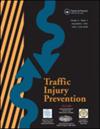Head injuries related to bicycle collisions and helmet use – an observational study
IF 1.6
3区 工程技术
Q3 PUBLIC, ENVIRONMENTAL & OCCUPATIONAL HEALTH
引用次数: 0
Abstract
Objectives
In Denmark, the use of bicycles is widespread, and head injuries are often seen in cyclists involved in collisions. Despite the well-known effects of using a helmet to reduce head injuries, using helmets is not mandatory in Denmark. The primary objective of this study was to provide data regarding injury outcomes and helmet usage.
Methods
Participants were bicyclists who sustained head injuries in bicycle collisions and were assessed by the Copenhagen Emergency Medical Services between 1 January 2016; and 15 June 2019. Patients with suspected head injury were identified in an electronic prehospital patient record. Data were linked to the Danish National Patient Registry to retrieve the diagnosis and were categorized into head injury or no head injury based on the diagnosis. Adjusted logistic regression analyses were reported with odds ratios and corresponding confidence intervals to assess the risk of head injury while adjusting for risk factors like age, sex, alcohol consumption, occurrence during weekends and traumatic brain injury.
Results
A total of 407 patients were included in this study. Within this entity, 247 (61%) had sustained a head injury. The use of a helmet was reported in one-third of the included patients. Among the head-injured patients, 13% sustained moderate to severe head injuries. Patients with suspected alcohol involvement were significantly less likely to report the use of a helmet. Helmet use reduced the risk of head injury with an odds ratio of 0.52, (95% CI 0.31 − 0.86). In high-energy trauma, the use of a helmet showed a significant reduction in the risk of sustaining a head injury with an odds ratio of 0.28, (95% CI 0.12 − 0.80).
Conclusions
In this study, using a helmet was associated with a significantly decreased risk of head injury; this association was even more significant in high-energy trauma.
与自行车碰撞和头盔使用有关的头部伤害--一项观察性研究。
目的:在丹麦,自行车的使用非常普遍,骑车人在发生碰撞时头部经常受伤。尽管众所周知使用头盔可以减少头部伤害,但在丹麦使用头盔并不是强制性的。这项研究的主要目的是提供有关受伤结果和头盔使用情况的数据:研究对象为 2016 年 1 月 1 日至 2019 年 6 月 15 日期间在自行车碰撞中头部受伤并接受哥本哈根紧急医疗服务评估的骑车者。院前病人电子病历对疑似头部受伤的病人进行了识别。数据与丹麦国家患者登记处相连,以检索诊断结果,并根据诊断结果分为头部受伤或无头部受伤。在对年龄、性别、饮酒量、周末发生率和脑外伤等风险因素进行调整后,报告了调整后的逻辑回归分析、几率比和相应的置信区间,以评估头部受伤的风险:本研究共纳入 407 名患者。其中 247 人(61%)头部受过伤。据报告,三分之一的患者使用了头盔。在头部受伤的患者中,13%的患者头部受到中度至重度伤害。疑似酗酒的患者报告使用头盔的可能性明显较低。头盔的使用降低了头部受伤的风险,几率比为 0.52(95% CI 0.31 - 0.86)。在高能量创伤中,使用头盔可显著降低头部受伤的风险,几率比为 0.28(95% CI 0.12 - 0.80):在这项研究中,使用头盔可显著降低头部受伤的风险;这种关联在高能量创伤中更为明显。
本文章由计算机程序翻译,如有差异,请以英文原文为准。
求助全文
约1分钟内获得全文
求助全文
来源期刊

Traffic Injury Prevention
PUBLIC, ENVIRONMENTAL & OCCUPATIONAL HEALTH-
CiteScore
3.60
自引率
10.00%
发文量
137
审稿时长
3 months
期刊介绍:
The purpose of Traffic Injury Prevention is to bridge the disciplines of medicine, engineering, public health and traffic safety in order to foster the science of traffic injury prevention. The archival journal focuses on research, interventions and evaluations within the areas of traffic safety, crash causation, injury prevention and treatment.
General topics within the journal''s scope are driver behavior, road infrastructure, emerging crash avoidance technologies, crash and injury epidemiology, alcohol and drugs, impact injury biomechanics, vehicle crashworthiness, occupant restraints, pedestrian safety, evaluation of interventions, economic consequences and emergency and clinical care with specific application to traffic injury prevention. The journal includes full length papers, review articles, case studies, brief technical notes and commentaries.
 求助内容:
求助内容: 应助结果提醒方式:
应助结果提醒方式:


